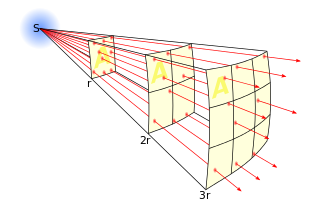Inverse square law

A number of physical properties (like the force between two charges) get smaller as they get farther apart in a way that can be represented by an inverse square law. This means that the intensity of the property decreases in a particular way as the distance between interacting objects increases. Specifically, an inverse square law says that intensity equals the inverse of the square of the distance from the source. For example, the radiation exposure from a point source (with no shielding) gets smaller the farther away it is. If the source is 2x as far away, it's 1/4 as much exposure. If it's 10x farther away, the radiation exposure is 100x less.
Inverse square laws always look something like this:
- is the quantity or intensity (sound, light, electric field)
- is the distance from the centre (rather than the surface)
Some examples of the inverse square law are:
- universal law of gravity
- electric fields and forces
- intensity of light
- radiation from a source
- intensity of sound (although we hear sound on a logarithmic scale in decibels)
Hyperphysics explores this idea further. The famous physicist Richard Feynman came up with an illustration of why intensities drop as the square of the distance by imagining buttering bread using a "butter gun." Roger Linsell created a non-imaginary butter gun and then created a video of this butter gun explaining the inverse square law:[2]
References
- ↑ Borb [GFDL (http://www.gnu.org/copyleft/fdl.html) or CC BY-SA 3.0 (http://creativecommons.org/licenses/by-sa/3.0)], via Wikimedia Commons https://commons.wikimedia.org/wiki/File%3AInverse_square_law.svg accessed August 26th, 2017.
- ↑ Permission given in private communication to embed Roger Linsell's video

